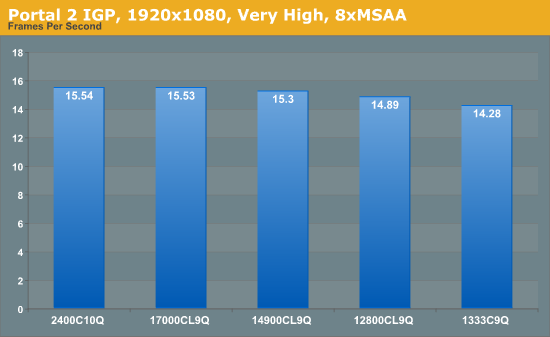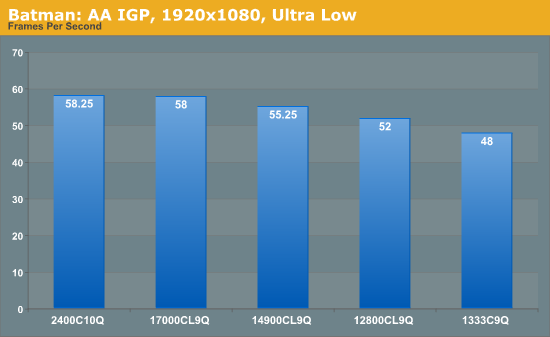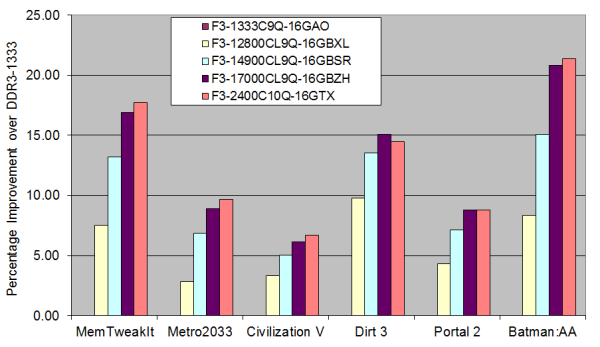Memory Performance: 16GB DDR3-1333 to DDR3-2400 on Ivy Bridge IGP with G.Skill
by Ian Cutress on October 18, 2012 12:00 PM EST- Posted in
- Memory
- G.Skill
- Ivy Bridge
- DDR3
Portal 2
A stalwart of the Source engine, Portal 2 is the big hit of 2011 following on from the original award-winning Portal. In our testing suite, Portal 2 performance should be indicative of CS:GO performance to a certain extent. Here we test Portal 2 at 1920x1080 with High/Very High graphical settings.

Portal 2 mirrors previous testing, albeit our frame rate increases as a percentage are not that great – 1333 to 1600 is a 4.3% increase, but 1333 to 2400 is only an 8.8% increase.
Batman Arkham Asylum
Made in 2009, Batman:AA uses the Unreal Engine 3 to create what was called “the Most Critically Acclaimed Superhero Game Ever”, awarded in the Guinness World Record books with an average score of 91.67 from reviewers. The game boasts several awards including a BAFTA. Here we use the in-game benchmark while at the lowest specification settings without PhysX at 1920x1080. Results are reported to the nearest FPS, and as such we take 4 runs and take the average value of the final three, as the first result is sometimes +33% more than normal.

Batman: AA represents some of the best increases of any application in our testing. Jumps from 1333 C9 to 1600 C9 and 1866 C9 gives an 8% then another 7% boost, ending with a 21% increase in frame rates moving from 1333 C9 to 2400 C10.
Overall IGP Results
Taking all our IGP results gives us the following graph:
The only game that beats the MemTweakIt predictions is Batman: AA, but most games follow the similar shape of increases just scaled differently. Bearing in mind the price differences between the kits, if IGP is your goal then either the 1600 C9 or 1866 C9 seem best in terms of bang-for-buck, but 2133 C9 will provide extra performance if the budget stretches that far.











114 Comments
View All Comments
vegemeister - Friday, October 19, 2012 - link
Most of the (still tiny) difference that appeared in the x264 benchmark was in the first pass. Two pass encodes really only make sense when you're trying to fit a single video onto a single storage device. That's an extremely uncommon use case these days, for everyone but the people mastering blu-rays.jonyah - Thursday, October 18, 2012 - link
"I remember buying my first memory kit ever. It was a 4GB kit of OCZ DDR2 for my brand new E6400 system, and at the time I paid ~$240, sometime back in 2005."I remember buying my first kit too. It was an upgrade from the 2MB I had to 6MB (yes MB, not GB), and that 6MB cost me $200 as well, this was back in 1995. Ten years and we had a 1000x improvement in size and who knows how much in speed.
rchris - Thursday, October 18, 2012 - link
Well, dang it! All these "I remember..." comments have really made me feel old. In my case it was paying $300 for a used 1MB board for a Zenith Z100. Can't even remember the year--somewhere in the mid- to late-1980s.IanCutress - Thursday, October 18, 2012 - link
I should point out that the kit I got was my first purchased kit on its own... Many computers before then where they were built my family or came pre-built.On the topic of A10 comparisons, I had thought of doing some in the future if enough interest was there. As the majority of CPU sales is in Intel's favor, we went with Intel first. (Also most of the testing for this review occurred before I had an A10 sample at hand.)
Ian
Termie - Thursday, October 18, 2012 - link
Great article, Ian. Thanks for taking on this challenge and enlightening us all.Don't worry about all the old-timers bugging you about your first build being in this century. It's not like they could have written this article!
arthur449 - Thursday, October 18, 2012 - link
I'd love to see an AMD CPU test run with the same memory kits and the same test suite to contrast the differences in performance gains offered by faster memory between the two major CPU platforms.lowenz - Thursday, October 18, 2012 - link
Make an extension to this brilliant article with new Trinity A8 / A10 and you'll be an instant geek hero.frozentundra123456 - Thursday, October 18, 2012 - link
Could you do a similar test in laptops, A10 vs HD4000? Like I said in my other post, this is where I see more possibility of igps actually being used for gaming. I also think this is where HD4000 is most competitive to AMD, in a power limited scenario.DanNeely - Thursday, October 18, 2012 - link
Have laptop bios's opened up enough in the last few years to let you specify memory timings? The advice I've always seen was to buy the cheapest ram at your laptops designated clockspeed because you won't be able to set the faster timings even if you wanted.haplo602 - Friday, October 19, 2012 - link
You have ONE set for each frequency, WHY the hell are you using the stupid model numbers in the graphs ????WHO CAME UP WITH THAT STUPID IDEA ????
otherwise the review is solid.